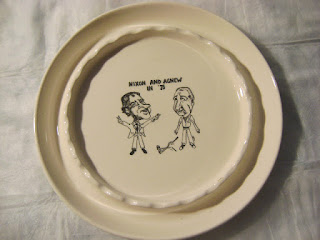
Grover Cleveland was the first Democratic President following the Civil War. . Cleveland also is the only U.S. President to serve two nonconsecutive terms (1885–1889 and 1893–1897) and therefore is the only individual to be counted twice in the numbering of the presidents. He also was a man of tremendous girth so that it is not clear whether the pottery pig shown here was a ceramic artifact from his supporters or his detractors.

Teddy Roosevelt became Chief Executive in 1901 when, as vice president, President McKinley was assassinated. Roosevelt was 42 years old when sworn in as President of the United States in 1901, making him the youngest president ever. Known for his “cowboy” persona, Roosevelt declared once that in foreign affairs it was good to “walk softly but carry big stick.” An enterprising potter incorporated that idea in a corked whiskey flask. The item probably dates from Teddy’s second term, 1905-1909.

Old timers may remember the time when the rooster was a popular symbol of Democrats. In the 20th Century it was the donkey that came to epitomize the party of Jefferson and Jackson. Here it is a ceramic figural labeled “New Deal Coin Bank.” The designation likely was a sarcastic comment on President Franklin Roosevelt’s programs which were widely attacked by for allegedly putting money into Democratic
 coffers.
coffers.Like the donkey, the elephant has become a familiar object in political parlance as a symbol for the Republican Party. Less well known may be Everett Dirksen, after whom one of the Washington D.C. Senate office buildings is named. In December 1943, Congressman Dirksen announced that he would be a candidate for the Republican Presidential nomination in 1944. He stated that a coalition of Midwestern Republican Congressmen had urged him to run and that his campaign was serious. Word was he really was trying to syphon votes away from another Midwest Republican, Wendell Wilkie, or was angling to become vice president. When all
 was
said and done, Dirksen received not a single vote for either office at
the 1944 Republican Convention. He subsequently would be elected to the
U.S. Senate and part of the Republican leadership there.
was
said and done, Dirksen received not a single vote for either office at
the 1944 Republican Convention. He subsequently would be elected to the
U.S. Senate and part of the Republican leadership there.Adlai Stevenson was another politician who twice sought the presidency. Stevenson had been a very successful governor of Illinois and the Democratic Party was strongly behind his candidacy. But in the elections of both 1952 and 1956 he faced Dwight D. Eisenhower, a World War Two general and hero. A coffee cup depicted Stevenson apparently riding the Demo donkey toward the White House. He never got
 there.
there.The ceramic ashtray, next in line, is clearly a satire with its message: “Nixon and Agnew in ‘76.” By the time of the 1976 Presidential campaign, Richard Nixon had left the White House in disgrace over Watergate and Spiro Agnew had preceded him from the vice presidency because of a criminal conviction in Maryland. Neither was in the slightest contention for the Republican nomination. Jerry Ford and Nelson Rockefeller were the (losing) GOP candidates that year. The winner, however, was a man whose toothy grin marked a field day for cartoonists and caricaturist -- Jimmy Carter. His face is unmistakable on a ceramic coffee mug.
 Beer mugs and coffee cups frequently have been the utilitarian ceramic of choice for political comment. The elephants shown here, dancing in line, date from 1987 during the Reagan Administration. Republicans in Congress were well known for hewing to party discipline and doing the will of the President. The cup is an affectionate spoof on “keeping the party line.”
Beer mugs and coffee cups frequently have been the utilitarian ceramic of choice for political comment. The elephants shown here, dancing in line, date from 1987 during the Reagan Administration. Republicans in Congress were well known for hewing to party discipline and doing the will of the President. The cup is an affectionate spoof on “keeping the party line.”Our final piece brings the story pretty much up to date. The last ceramic is a small statue of George W. Bush. Bush is as recognizable on the item as the former President as Jimmy Carter on the coffee mug. Nevertheless, I am somewhat mystified by the crown. In fairness, whatever Bush’s
 shortcomings may have been, taking on imperial airs was not one of them. That said, the statue fully is in the American tradition of satirizing our leaders.
shortcomings may have been, taking on imperial airs was not one of them. That said, the statue fully is in the American tradition of satirizing our leaders.Here we have seen politicians described and sometimes satirized in pottery “feats of clay.” Not a new phenomenon. We have seen examples ranging for more than 132 years in American history. Let’s hope the tradition lasts another 127 years, one symbol of free speech in America. And, by the way, a source of interesting collectibles.


No comments:
Post a Comment